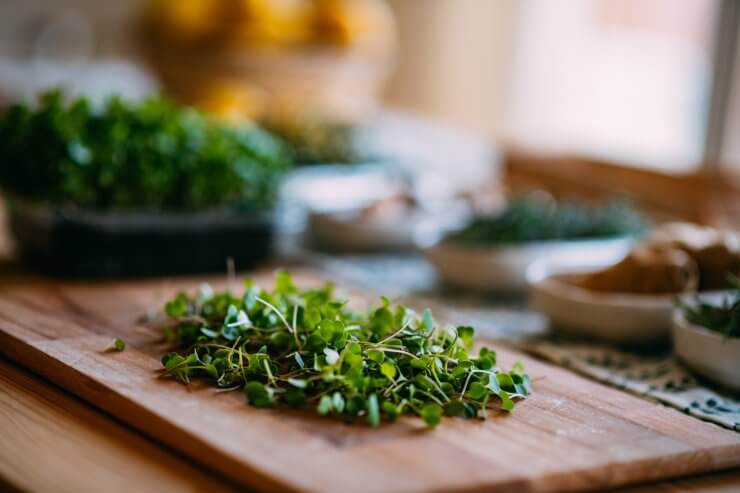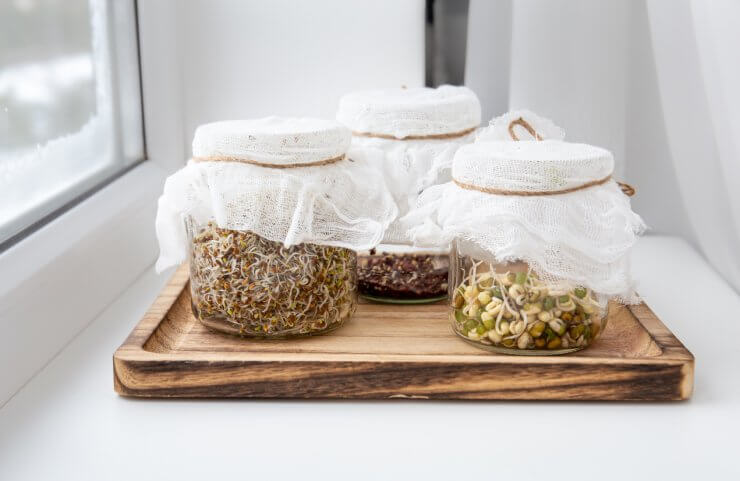
December in zones 4-6 is when the garden is tucked under a blanket of snow, and the only thing growing outside is your collection of wool socks. With average temperatures ranging from a brisk 35°F down to a bone-chilling 0°F (2°C to -18°C), and soil frozen harder than last year’s fruitcake, traditional outdoor planting is pretty much out of the question.
But before you hang up your gardening gloves until spring, there’s good news! While our outdoor gardens might be taking a well-deserved winter nap, December is the perfect time to flex your green thumb indoors and tackle some important winter garden tasks. Plus, with a little planning and the right setup, you can still grow fresh herbs and greens right on your windowsill while the winter winds howl outside.
So, grab your favorite warm beverage, pull up a cozy chair, and let’s explore how to keep your gardening passion alive during the coldest month of the year. Trust me, your spring garden will thank you for staying active during the winter months!
What to Grow Indoors in December
1. Microgreens

Microgreens
Just because there’s snow on the ground doesn’t mean you can’t enjoy fresh, homegrown greens. Microgreens are the perfect winter growing project – they’re quick, easy, and packed with nutrients. In fact, these tiny powerhouses can contain up to 40 times more vitamins and nutrients than their fully-grown counterparts. Plus, they take up minimal space, making them perfect for apartment gardeners or anyone with limited growing area.
These diminutive greens are ready to harvest in just 1-3 weeks, and they pack more flavor into their tiny leaves than you might think possible. Radish microgreens offer a spicy kick, while pea shoots bring a sweet, fresh taste of spring to your winter meals. Sunflower shoots provide a nutty crunch that can elevate any sandwich or salad.
Best varieties for indoor growing:
- Radish microgreens (ready in 7-10 days): Spicy and crisp, perfect for sandwiches
- Sunflower shoots (ready in 7-14 days): Nutty and substantial, great in salads
- Pea shoots (ready in 10-14 days): Sweet and tender, delicious in stir-fries
- Mustard microgreens (ready in 7-10 days): Peppery kick, excellent on eggs
The key to successful microgreen growing is to create the right environment. You’ll want to start with a shallow tray that has drainage holes – those plastic clamshell containers from grocery store berries work great if you add some holes. Fill with 1-2 inches of sterile seed starting mix, and sow your seeds densely – we’re talking shoulder-to-shoulder here. Keep the soil consistently moist but not waterlogged (a spray bottle is your friend), and provide 4-6 hours of direct sunlight or 12-16 hours under grow lights. If you’re feeling lazy, I also love the Hamama microgreen growing kits. I reviewed different microgreen growing methods in my video, Growing Microgreens: Kits vs. DIY if you want to learn more.

Seeds sprout in glass jars
2. Sprouts: The No-Soil Solution
Even easier than microgreens, sprouts are like the gateway drug to indoor winter gardening. They require no soil, minimal equipment, and can be ready to eat in as little as 3-7 days. Plus, they’re incredibly nutritious and can add a fresh, crisp element to your winter meals when fresh produce might be looking a bit sad at the grocery store.
The best part about sprouting? It’s nearly foolproof. All you need is a clean mason jar, a sprouting lid (or piece of cheesecloth and a rubber band), and some sprouting seeds. The key to success is rinsing your sprouts 2-3 times daily and keeping them at room temperature out of direct sunlight.
Best varieties for sprouting:
- Alfalfa: The classic sprout, mild flavor perfect for sandwiches
- Mung beans: Crunchy and versatile, great for Asian dishes
- Broccoli: Packed with nutrients, slightly spicy
- Radish: Adds a zesty kick to salads and sandwiches
The sprouting process is simple but requires attention to cleanliness to prevent mold. Start by soaking your seeds for 8-12 hours, then drain and rinse thoroughly. Continue rinsing 2-3 times daily, making sure to drain well each time. Your sprouts should be ready when they’ve grown tails.
3. Indoor Lettuce Herbs: Your Kitchen Window Garden
There’s something incredibly satisfying about snipping fresh lettuce and herbs from your windowsill in the middle of winter. While not all herbs thrive indoors, several varieties can provide you with fresh flavors all winter long. The key is choosing the right varieties and creating conditions that mimic their natural environment as much as possible. Learn more about growing lettuce in our Lettuce Gardening Guide.
Best lettuces and herbs for indoor growing:
- Buttercrunch Lettuce (Butterhead): Can be trimmed many times before you need to replant.
- Basil: Needs plenty of light but rewards you with fragrant leaves
- Parsley: Tolerates lower light conditions and grows steadily
- Chives: Easy to grow and provides continuous harvests
- Mint: Vigorous grower that can thrive indoors
- Thyme: Compact and flavorful, perfect for small spaces
Success with indoor herbs starts with the right location. A sunny south-facing window is ideal, but if you don’t have one, don’t worry – grow lights can work wonders. Use well-draining potting soil and containers with drainage holes to prevent root rot. Water when the top inch of soil feels dry, but be careful not to overwater – more herbs die from drowning than drought. A good hydroponic system can make all of this very easy, check out my Hydroponics for Beginners: 5 Systems for Growing Greens and Veggies video.
Essential December Garden Tasks for Zones 4-6
Protection and Maintenance
December’s harsh weather can be tough on our dormant gardens, but a little vigilance now can prevent major headaches come spring. While it might be tempting to stay inside with a hot cup of cocoa (and trust me, I don’t blame you), regular checks of your winter protection measures can make the difference between plants that thrive and those that barely survive our zone’s challenging winters. Think of yourself as a garden guardian, keeping watch over your sleeping plant babies.
- Check winter protection on vulnerable plants and add additional mulch if needed
- Ensure winter protection structures (cold frames, hoop houses) are secure
- Brush heavy snow off evergreens and shrubs to prevent branch breakage
- Check stored bulbs and tubers for signs of rot or drying out
Tool Care and Organization
December is the perfect time to show your hardworking garden tools some love. After all, they’ve been your faithful companions through spring planting, summer maintenance, and fall cleanup. Taking care of them now means they’ll be ready to jump back into action when the first hints of spring arrive. Plus, there’s something deeply satisfying about organizing and maintaining your garden equipment while winter rages outside.
- Clean, sharpen, and oil garden tools
- Organize seed storage containers
- Take inventory of supplies needed for spring
- Clean and disinfect plant containers and trays for spring use
Planning and Preparation
While the garden sleeps under its winter blanket, December offers a wonderful opportunity to dream and scheme about next year’s garden. This is when you can let your imagination run wild, poring over seed catalogs and planning new garden beds. It’s like being an architect, but instead of buildings, you’re designing future harvests and beautiful blooming spaces.
- Review last season’s garden journal
- Plan next year’s garden layout
- Order seeds early for best selection
- Test stored seeds for viability
- Start gathering supplies for seed starting in January
Winter Pruning
December’s bare branches make it the ideal time to see your trees’ and shrubs’ true structure. Without leaves in the way, you can easily identify problem areas and shape your woody plants for better growth come spring. Think of winter pruning as giving your trees and shrubs a haircut – it’s all about maintaining good form and removing the dead ends.
- Prune damaged or dead branches from trees and shrubs
- Shape fruit trees while they’re dormant
- Remove crossing or rubbing branches
- Wait to prune spring-flowering shrubs until after they bloom
Fruit Tree Care
Your dormant fruit trees might look like they don’t need attention, but winter care is crucial for a bountiful harvest next year. December is when hungry rodents and winter pests can do serious damage if left unchecked. Regular monitoring now can prevent heartbreak when spring arrives. Consider yourself a winter guardian for your future fruit harvest.
- Apply winter wash to fruit trees to combat overwintering pests
- Check tree guards are secure against rodent damage
- Monitor for winter damage after storms
- Remove any remaining mummified fruits
Composting
Just because the garden is dormant doesn’t mean your compost pile should be! Winter composting requires a different approach than summer, but maintaining your pile now means you’ll have rich, beautiful compost ready for spring planting. Think of it as cooking up a slow-winter stew of nutrients for your future garden.
- Continue adding kitchen scraps to compost
- Turn indoor compost bins monthly
- Monitor moisture levels in covered compost
- Add brown materials (leaves, paper) to balance green kitchen waste
Indoor Garden Maintenance
Your indoor plants become even more precious during winter months, serving as little oases of green in a world of white and gray. December is when they need extra attention as they cope with lower light levels and dry indoor air. Creating the right environment for them now will keep them healthy until spring returns.
- Monitor houseplants for pests
- Clean plant leaves to maximize light absorption
- Reduce watering frequency for dormant plants
- Maintain humidity with pebble trays or humidifiers
Record Keeping
December’s quiet days provide the perfect opportunity to reflect on your garden’s past year and plan for its future. Good records are like a garden time machine – they help you learn from past successes and failures while making better plans for the seasons ahead. Plus, there’s something cozy about updating your garden journal while watching snowflakes fall outside.
- Update garden journal with winter observations
- Document winter damage for future reference
- Plan crop rotation for spring
- Make wish lists for spring plants and projects
Remember, December in zones 4-6 isn’t about outdoor planting – it’s about preparation, protection, and planning. Use this quiet time to catch up on garden literature, organize your seed collection, and dream about next year’s garden. And hey, those microgreens you’re growing inside might just be the freshest salad ingredients in the neighborhood!
What indoor growing projects are you planning this December? Or maybe you have some creative winter garden preparation tips to share? Drop a comment below and let’s keep our gardening community thriving even in the depths of winter!


 Previous
Previous

